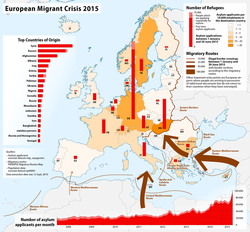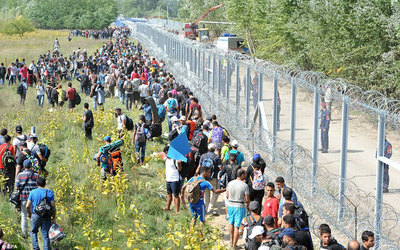2016 SCHOLARSHIP
HUMAN MIGRATION
Scholarship Workshops at Auckland University - 2016
Workshop #1: Wednesday 8th June, 4 - 6pm
Workshop #2: Wednesday 31st August, 4 - 6pm
Workshop #3: TBC
Workshop #1: Wednesday 8th June, 4 - 6pm
Workshop #2: Wednesday 31st August, 4 - 6pm
Workshop #3: TBC
The Format of the 2016 Exam
The examination will be resource-based.
In 2016, the examination questions and resource booklet will focus on Human Migration
Some resource materials (such as maps, text, photographs, models, graphs, tables and cartoons) related to this theme will be provided, to assist candidates within this geographic context.
Candidates will be required to complete questions that involve selecting, extracting, analysing, processing, predicting, justifying, and presenting information. Candidates will be required to include relevant original visuals that will enhance their answers.
Candidates will be expected to demonstrate understanding of a range of geographic perspectives and to use their geographic knowledge, skills, ideas, and understanding to support their answers.
Candidates should use coloured pencils in their diagrams / maps. Annotations on these diagrams / maps must be in pen. Any work done in pencil will not be eligible for reconsideration.
The examination will be resource-based.
In 2016, the examination questions and resource booklet will focus on Human Migration
Some resource materials (such as maps, text, photographs, models, graphs, tables and cartoons) related to this theme will be provided, to assist candidates within this geographic context.
Candidates will be required to complete questions that involve selecting, extracting, analysing, processing, predicting, justifying, and presenting information. Candidates will be required to include relevant original visuals that will enhance their answers.
Candidates will be expected to demonstrate understanding of a range of geographic perspectives and to use their geographic knowledge, skills, ideas, and understanding to support their answers.
Candidates should use coloured pencils in their diagrams / maps. Annotations on these diagrams / maps must be in pen. Any work done in pencil will not be eligible for reconsideration.
What is Migration?
Human migration is the movement by people from one place to another with the intentions of settling temporarily or permanently in the new location. The movement is often over long distances and from one country to another. Internal migration is also possible - this is the most dominant form of human migration globally.
Migration - The movement of a person or a group of persons, either across an international border, or within a State. It is a population movement, encompassing any kind of movement of people, whatever its length, composition and causes; it includes migration of refugees, displaced persons, economic migrants, and persons moving for other purposes, including family reunification.
Migrant - At the international level, no universally accepted definition for "migrant" exists. The term migrant was usually understood to cover all cases where the decision to migrate was taken freely by the individual concerned for reasons of "personal convenience" and without intervention of an external compelling factor; it therefore applied to persons, and family members, moving to another country or region to better their material or social conditions and improve the prospect for themselves or their family. The United Nations defines migrant as an individual who has resided in a foreign country for more than one year irrespective of the causes, voluntary or involuntary, and the means, regular or irregular, used to migrate. Under such a definition, those travelling for shorter periods as tourists and businesspersons would not be considered migrants. However, common usage includes certain kinds of shorter-term migrants, such as seasonal farm-workers who travel for short periods to work planting or harvesting farm products.
Human migration is the movement by people from one place to another with the intentions of settling temporarily or permanently in the new location. The movement is often over long distances and from one country to another. Internal migration is also possible - this is the most dominant form of human migration globally.
Migration - The movement of a person or a group of persons, either across an international border, or within a State. It is a population movement, encompassing any kind of movement of people, whatever its length, composition and causes; it includes migration of refugees, displaced persons, economic migrants, and persons moving for other purposes, including family reunification.
Migrant - At the international level, no universally accepted definition for "migrant" exists. The term migrant was usually understood to cover all cases where the decision to migrate was taken freely by the individual concerned for reasons of "personal convenience" and without intervention of an external compelling factor; it therefore applied to persons, and family members, moving to another country or region to better their material or social conditions and improve the prospect for themselves or their family. The United Nations defines migrant as an individual who has resided in a foreign country for more than one year irrespective of the causes, voluntary or involuntary, and the means, regular or irregular, used to migrate. Under such a definition, those travelling for shorter periods as tourists and businesspersons would not be considered migrants. However, common usage includes certain kinds of shorter-term migrants, such as seasonal farm-workers who travel for short periods to work planting or harvesting farm products.
University Workshop #1
In case you lost the resources from the workshop, download them below, along with a video of the speaker on the 'Human Migration'.
|
|
|
|
| ||||||||||||
University Workshop #2
|
| ||||||||||||
University Workshop #3
|
|
|
| 2016-agta-scholarship-geography-workshop-three.docx | |
| File Size: | 800 kb |
| File Type: | docx |
Case Studies:
Mexico and Central America to USA
The US Mexico border area and the desert route from West Africa to Libya are the most dangerous land routes, with migrants perishing in train accidents, murdered, or dying of thirst in their quest for a better life.
The US Mexico border area and the desert route from West Africa to Libya are the most dangerous land routes, with migrants perishing in train accidents, murdered, or dying of thirst in their quest for a better life.
|
America's Immigration History (Published December 2014)
A TDC original documentary explaining the history of immigration to America, from the "Natives" who first populated the land, through to the Mexican migrants who come in large numbers today. |
|
|
Americans React to Hearing the Word Immigrant (Published October 2015)
“What's the first thing you think of when you hear the word 'immigrant'?” We asked young people in New York City, St. Louis, Texas and San Francisco. |
|
|
Hey Americans, Come Take Our Jobs! (Published July 2014)
However you feel about the 11 million immigrants living illegally in the United States, you should know that about one million of them are farm workers. Are they taking our jobs or are they keeping us from starving? Charlie LeDuff took a trip to the food basket of the world, the San Joaquin Valley in Central California to find out. |
|
|
Illegal Immigrants Face Dangerous Mexican/US Border — One Story (Published April 2014)
They leave their communities and loved ones behind for a better life in the United States. The journey is perilous and survival is not guaranteed. There is illegal immigration - which side of the fence are you on? Walk in the footsteps of these Migrants. |
|
|
The Border Crisis - The real impact of illegal immigration (Published October 2014)
This video is for Americans that believe in sovereignty. This failure to secure our borders is a push for the North American Union and Agenda 21. |
|
|
Broken lives of immigrants deported from US to Mexico - BBC News (Published on March 2014)
Almost two million undocumented immigrants have been deported from the US since Barack Obama entered the White House, more than under any previous president. |
|
|
The Obama Administration's Massive Deportation Plan (Published December 2015)
'The O'Reilly Factor' examines the crisis at the southern border. Jesse Watters talk about Border Security, Demographics, Deportation, Enforcement, Illegal Immigrants, and Immigration. |
|
Case Study 2: European Union
|
|
The war in Syria explained in five minutes | Guardian Animations
|

Migrant Crisis: Migration to Europe explained in graphics (Published 22 December 2015)
More than a million migrants and refugees crossed into Europe in 2015, sparking a crisis as countries struggle to cope with the influx and creating division in the EU over how best to deal with resettling people.
http://www.bbc.com/news/world-europe-34131911
More than a million migrants and refugees crossed into Europe in 2015, sparking a crisis as countries struggle to cope with the influx and creating division in the EU over how best to deal with resettling people.
http://www.bbc.com/news/world-europe-34131911
|
|
Migrant crisis: The Facts - BBC News (Published September 2015)
The migrant crisis in Europe is growing more harrowing by the day - the struggle for some ends with their death washed up on beaches still populated with end-of season holidaymakers. Others are crammed into railway stations - desperate for a train to take them closer to Germany. There are many routes that tens of thousands of migrants across Europe are attempting. Here's the BBC's Jim Reed with some facts. |
|
|
TED TALK - Refugees in Europe: a crisis of connection - Dace Dzenovska
In the age of mobility, more people are on the move than ever before. Yet many of those who are on the move — the illegal migrants, are dying at sea. Is keeping people in place the best solution to the crisis of migration? Dace Dzenovska wants to take you to a different place — a place of responsible connectedness — from which to think about migration and the current crisis in the Mediterranean. |
Searching For Meaning – Which Media Report Do You Believe?
Below there are a number of reports on the long articles around the little Syrian boy Aylan Kurdi. It is not intended for you to read all of these. Read the initial newspaper reports and then a few of the later reports.
Why are they different? Which is correct? How do we know? It is interesting to note the sources of the later articles. Might this affect the way Muslims refugees are viewed?
Why are they different? Which is correct? How do we know? It is interesting to note the sources of the later articles. Might this affect the way Muslims refugees are viewed?
Aylan Kurdi’s Story: How A Small Syrian Child Came To Be Washed Up On A Beach In Turkey
Click Here for the Article
Click Here for the Article
Aylan Kurdi’s father working with smugglers, drove the capsized boat, other passengers say
Click here for the Article
Click here for the Article

